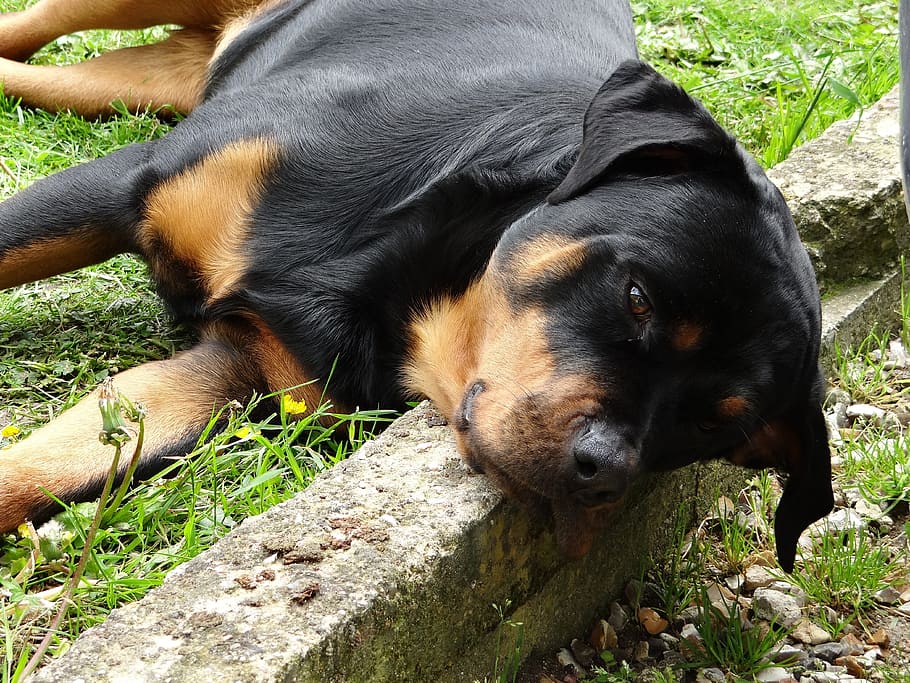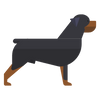Understanding Osteochondrosis in Your Rottweiler

Osteochondrosis is not the first thing that comes to mind when you first adopt a Rottweiler puppy. Unfortunately, this is a very common condition in young Rottweilers that you may need to work through. If this is something you are facing, this article will provide everything you need to understand and manage the condition.
Osteochondrosis in a Rottweiler is a condition of the joint cartilage, where the surface cartilage on the end surface of the bone is abnormal. This leads to inflammation and tearing of the cartilage and is mostly seen in the ankle/hock joint. Rapid growth or genetics are thought to play a role.
I will cover every aspect of this condition that is relevant to you and your Rottweiler in the article below. I have also included ways you can help your Rottweiler manage the condition and ways you can prevent problems in the first place.
Osteochondrosis in a Rottweiler
Osteochondrosis is a condition, seen in both dogs and humans, where the cartilage on the end of the bone at a joint is abnormal. It is usually only a small portion of the cartilage that is thicker or has not formed properly. The abnormal section of the cartilage is known as an 'osteochondral lesion'.
The lesion itself does not cause pain or reduced function of the joint. However, due to the abnormal shape or thickness of the cartilage, it is prone to rubbing when the joint is used. This can cause inflammation and tears in the cartilage.
There are three ways that an osteochondral lesion can cause pain and loss of function in the joint.
- The cartilage becomes inflamed with small cracks
- The cartilage tears and partially separates from the bone
- The cartilage separates completely from the bone and is loose in the joint.
Osteochondrosis describes the abnormality within the cartilage, but you may have also heard of 'Osteochondritis Dissecans'. This is a variation of osteochondrosis.
Osteochondritis Dissecans is used to describe the condition when the osteochondral lesion is inflamed and has separated from the bone. Osteochondrosis itself is not painful, but leads to Osteochondritis. Below is a breakdown of these words, which I find helps me understand.
- 'Osteo' - meaning bone
- 'Chondro' - meaning cartilage
- 'Osis' - meaning a state of disease
- 'Itis' - meaning inflammation
- 'Dissecans' - meaning to be separated from
Osteochondritis Dissecans is also known as OCD, OD or just Osteochondritis.
Symptoms & Diagnosis
The key to staying on top of this disease is to recognise the symptoms. Earlier detection leads to a better prognosis (outcome), which I will explain further down. Common symptoms are as follows.
Symptoms:
- Limping
- Swelling around the joint
- Joint is warm to touch
- Rottweiler flinches or cries out in pain when squeezing or manipulating the joint
- Lameness (can't walk)
Of course, there are always other diseases that have similar symptoms, known as a 'differential diagnosis'. Some other possible causes for these symptoms are joint dysplasia (very common in Rotties) or arthritis. This is why the vet will need to run tests to officially diagnose Osteochondrosis or Osteochondritis.
Diagnosis:
When you take your Rottweiler to the vet, they will check the joint themselves by feeling and manipulating it. From there, they could recommend any of the following.
- Xray: Plain images of the bones and joint.
- CT Scan: A more detailed image of the bones and joint.
- Arthroscopy: Making an incision near the joint and inserting a small camera on the end of a flexible tube to look at the physical joint in real-time.
Every vet will be different, but usually an arthroscopy is best to diagnose subtle changes in the joint. Because this is done by a surgeon, they can also cut away any loose cartilage in the same procedure. CT scans also show great detail, but treatment cannot be done at the same time.
X-rays, on the other hand, are the cheapest option and are normally the first line of imaging. However, if your Rottweiler is in the early stages of the disease, it may not be seen on the x-ray.
Treatment & Recovery
Depending on the extent of the disease, the inflamed or torn cartilage has the potential to heal over. This will return the cartilage back to a state of 'normal'. However, if there is any abnormality in the surface of the bone after healing, the disease could flare up again.
If Osteochondrosis is left untreated, inflammation can lead to early onset of arthritis in that joint. Arthritic changes to the bone are irreversible and will require joint replacement to prevent lameness.
Conservative Treatment
Conservative treatments include those that do not involve surgery. These treatments are most effective in cases where the cartilage is still connected to the bone (even if only partly). You can expect this recovery to take 6-8 weeks.
- Rest: Avoid sports and excessive exercise. Take your Rottweiler for short walks on the leash to reduce further damage while they recover. After 3 weeks they may be able to do low-impact exercise like swimming.
- Joint Brace: Bracing the joint will take the pressure off the joint during recovery. Here is an example of one for the ankle/hock joint (Amazon).
- Physiotherapy: Passive range-of-motion (PROM) exercises imitate normal joint movement, but with your Rottie on their side, to help the cartilage heal normally.
- Medication: Anti-inflammatory medication and joint supplements can reduce pain and promote healing. Keep in mind that reducing pain with anti-inflammatories may encourage your Rottie to use the joint more than they should.
- Weight-loss: Excess weight can put unnecessary strain on your Rottweiler's joints. When you can, try to alter their diet and/or exercise regime to maintain a more healthy weight (see here for healthy weight of males vs females).
Keeping your Rottweiler in a temporary cage (or fenced-off space) may be the only answer if they are injuring themselves around the house. The methods above should help, but go with what you think works best for you Rottie.
Surgical Treatment
Surgery is good to remove any dead or loose cartilage from the joint, which will help clean it up. Cleaning up the joint will help it to resurface the bone with new cartilage.
This can be done via arthroscopy (keyhole surgery) or open surgery (large incision to open up the joint). Both of these options take around 8-12 weeks to recover.
One risk to surgery is the formation of scar tissue. Scar tissue forms around any cut, including those made to remove diseased cartilage, and the extent of scar tissue is different in every dog. Sometimes scar tissue can form within the joint, creating another osteochondral lesion.
You can also expect to pay around $2,000-$4,000 per joint. Your Rottweiler will then have to rest and do PROM exercises following the surgery.
Preventing Osteochondrosis in Your Rottweiler
In order to prevent Osteochondrosis in your Rottweiler, it is important to understand what causes the disease.
Possible Causes
The exact cause of Osteochondrosis is unknown. However, below are a number of possible causes that seem to increase a Rottweiler's risk of developing the condition.
Genetic Predisposition
Rottweilers born to parents with the condition are highly likely to develop it themselves. This is why many researchers believe genetics play a large role in causing the disease. Some theories suggest it may be a particular gene, or combination of genes, that results in abnormal joint formation.
Rapid Growth
Rottweilers puppies with too much energy and calcium in their diet may grow more rapidly than normal, due to the ability to build bone faster. Using the appropriate puppy food will help. Puppy food made for large dogs should have the right calcium balance for your Rottweiler.
Trauma/Blood Restriction
Restriction of the blood flow to the joint when it is forming can cause the cartilage surface to develop abnormally. This can be due to trauma or other restrictive mechanisms. Most trauma is caused by over-exercise as a puppy, which puts too much strain on the joints while they are developing.
Hormonal Imbalances
Hormones play a large role in the development of your Rottweiler's joints. Any disruption to these hormones can cause joints to develop abnormally, leading to diseases such as Osteochondrosis or Dysplasia. Some studies have shown that de-sexing (spaying/neutering) your Rottweiler too early can have this affect.
You can find more details on the affect of early de-sexing in this article.
Preventing Osteochondrosis
With the above causes in mind, below are some suggestions that can help prevent osteochondrosis in your Rottweiler.
- Avoid puppies from parents with the condition. Certified breeders should have this information available.
- Feed your Rottweiler puppy the correct food (food designed for big dog breeds).
- Limit your Rottweiler's exercise to their daily exercise requirements. Click here for more information.
- Delay spaying or neutering your Rottweiler until they are at least 2-years old.

